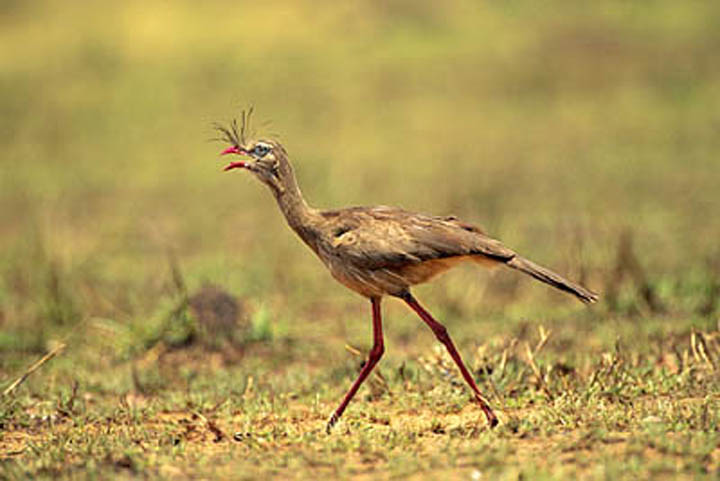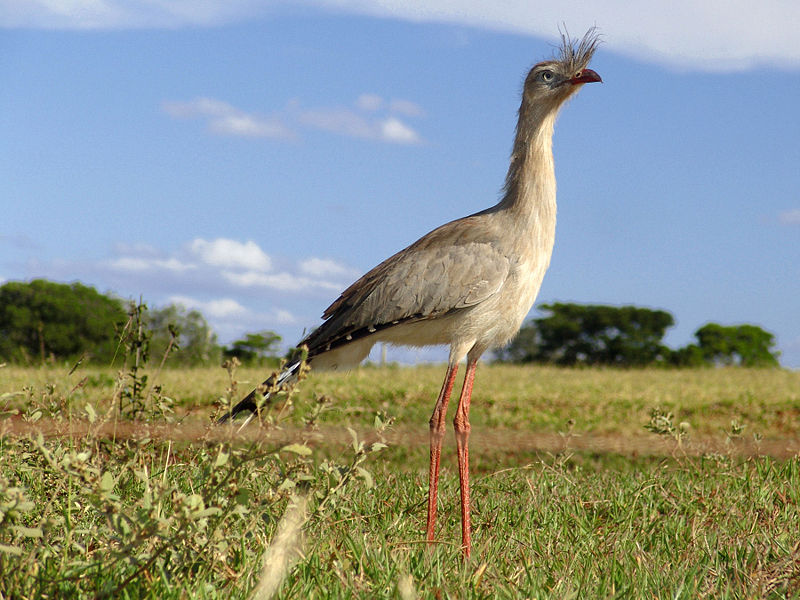
Cariama cristata
TAXONOMY
Palamedea cristata Linnaeus, 1766, Brazil.
OTHER COMMON NAMES
English: Crested seriema; French: Cariama huppй; German:
RotfuЯseriema; Spanish: cariama, siriema, Chuсa Pattiroja.
PHYSICAL CHARACTERISTICS
Red legs and bill, yellow iris surrounded by pale blue bare
skin, and a black subterminal bar on the white-tipped tail.
Plumage of the neck and underparts is soft and somewhat
loose. Long feathers on the hindneck form the nuchal crest,
whereas the distinctive frontal crest is formed by permanently
raised, stiffened feathers, 3–4 in (7–10 cm) in length,
arising from the base of the bill. Sexes similar, but males
slightly larger. Juveniles similar, but the bill and legs are
blackish, and the markings of the head, neck, and back are
more evident.
DISTRIBUTION
More widespread. Inhabits large parts of central and eastern
Brazil, Paraguay, eastern and southeastern Bolivia, Uruguay and
northeastern Argentina. Elevations up to 6,600 ft (2,000 m).
HABITAT
Primarily savanna-like areas; also open scrub and woodland edges.
BEHAVIOR
Generally nonmigratory, but temperature-related movement
recorded. Rarely fly and spend most of the time on the
ground, except for roosting in low trees or bushes. The birds
are fast on the ground and can outrun predators. Considered
diurnal. Dust bathing is practiced, as well as sunbathing, during
which birds of this species lie on their sides, sometimes appearing
as if dead. Call is similar to a yelping puppy and can
be heard several miles away. Call is usually given in the morning
and between pairs, often as a duet between the two birds,
to define territory. At the beginning of the call, the head is
held straight, but toward the end, the neck is held back so the
head nearly touches the bird’s back.
FEEDING ECOLOGY AND DIET
Omnivorous diet including small mammals, insects, snakes,
worms, frogs, birds, lizards, snails, fruit, and vegetable matter.
May eat eggs or chicks of other species. Slams large prey on
rocks to pulverize to make it easier to swallow. The arrangement
of their toes prevents them from catching prey with their
feet. Forage in small groups or pairs.
REPRODUCTIVE BIOLOGY
Nests are in bushes or low trees from ground level to 10 ft (3
m) up in a tree; sticks are used for building material with mud
and leaves for the lining. Both sexes build the nest, which generally
takes a month. The male’s courtship display involves
showing off flight feathers by stretching them to one side and
strutting before the female with head down and crest raised.
Seriemas are considered monogamous. Clutches usually consist
of two white eggs with irregular brown streaks. Incubation lasts
for 25–28 days with both parents involved. Chicks fledge in a
month.
CONSERVATION STATUS
Not threatened, though uncommon in far southern parts of
Brazil; rare and possibly vanishing in Uruguay. A population in
northeast Argentina appears to be pressured by hunting and destruction
of habitat. Has begun to colonize deforested, grassy
areas of Amazonian Brazil.
SIGNIFICANCE TO HUMANS
Occasionally offered for sale by illegal traders in parts of
Brazil. Farmers often use them as watchdogs for their domestic
fowl because of their call.
Photo Gallery of - Red-legged seriema




 Animalia Life
Animalia Life